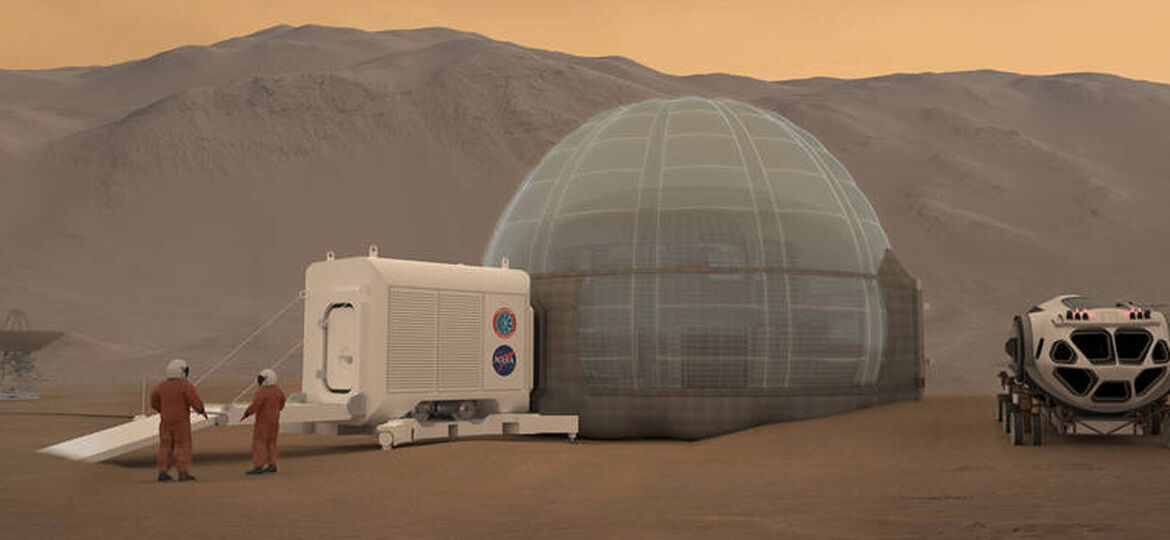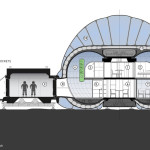
WHY THIS MATTERS IN BRIEF
- When the first astronauts arrive on Mars they’re going to need somewhere to eat, live and sleep, and NASA’s new icy concept could be just the home away from home they always wanted
There are a lot of hoops to jump through before anyone can set foot on Mars but, among all of the other challenges, one of the most challenging involves trying to figure out how the Martian astronauts will live their daily lives. Now, after a days worth of brainstorming, yes, a whole day, NASA engineers think they have the answer. And that answer is inflatable habitats covered in ice. You hear me right.
Based on the simulations NASA believes these new style habitats will be great places to sleep, eat and live and that they’ll protect the crews from the extreme temperatures and high radiation found on the red planet.
“After a day dedicated to identifying needs, goals, and constraints we rapidly assessed many crazy, out of the box ideas and finally converged on the current Ice Home design, which provides a sound engineering solution,” said senior systems engineer Kevin Vipavetz, from NASA’s Langley Research Centre in Virginia.
The very mention of the words ice, and ice home, bring igloos to mind and if you had an igloo pictured in your head you wouldn’t be far off. Officially the new concept is called the Mars Ice Home and it’s an inflatable, balloon like habitat that when inflated fully is covered with a thick sheet of protective ice.
“The Mars Ice Home design has several advantages that make it an appealing concept. It is lightweight and can be transported and deployed with simple robotics, then filled with water before the crew arrives,” said the team behind the design, “it incorporates materials extracted from Mars, and because water in the Ice Home could potentially be converted to rocket fuel for the Mars Ascent Vehicle, the structure itself doubles as a storage tank that can be refilled for the next crew.”
The main aim of the Ice Home concept is to protect astronauts from high energy radiation, such as cosmic rays, that can penetrate the Martian atmosphere which can damage cells, and raise a slew of health concerns, such as cancer and acute radiation sickness. However, since ice is hydrogen rich it acts as a shield against the dangerous rays.
“The materials that make up the Ice Home will have to withstand many years of use in the harsh Martian environment, including ultraviolet radiation, charged particle radiation, possibly some atomic oxygen, perchlorates, as well as dust storms,” explained researcher Sheila Ann Thibeault.
Asides from offering protection from the harsh environmental realities of Mars, the Ice Home would also be super light which is a big boost, bearing in mind that the recently announced SpaceX Falcon Heavy, which when built will be twice as powerful as the previous record holder, the Saturn V, can only lift 54 tons into orbit at a time – and that will include other cargo and all of the crew, as Elon Musk touted when he first announced SpaceX’s plans to head for the Red planet last year.
According to the design team, another good way of living on Mars is to live underground, which offers the best protection from all of the harmful things on the surface, to do that though the team would need some form of shelter while they burrow, and again, the team thinks that the Mars Ice Home could be the perfect solution.
“After months of travel in space, when you first arrive at Mars and your new home is ready for you to move in, it will be a great day,” sais team member Kevin Kempton.
Without the inflatable habitat, which the team says can inflate and cover itself with ice extracted from the Martian landscape in about 400 Earth days, researchers would have to have to find a way to get heavy drilling and digging machines on Mars to create underground shelters before astronauts got there, a concept that would be far too complicated and expensive.
In the meantime though the ice home is just a concept, but as we start turning our attention, and our dollars, on getting to the Red Planet in a few years time we might find out that it’s getting packed up and shipped out, headed for Mars.



















[…] for years and it’s fair to say that their plan, which has three distinct phases complete with Mars habitat concept, is already fairly well […]
[…] of surface area and shortage of food. The phenomenon is called “Island Dwarfism,” and under the Martian habitats, smaller might be better too. After all, there’s probably not that much space, and every pound of […]